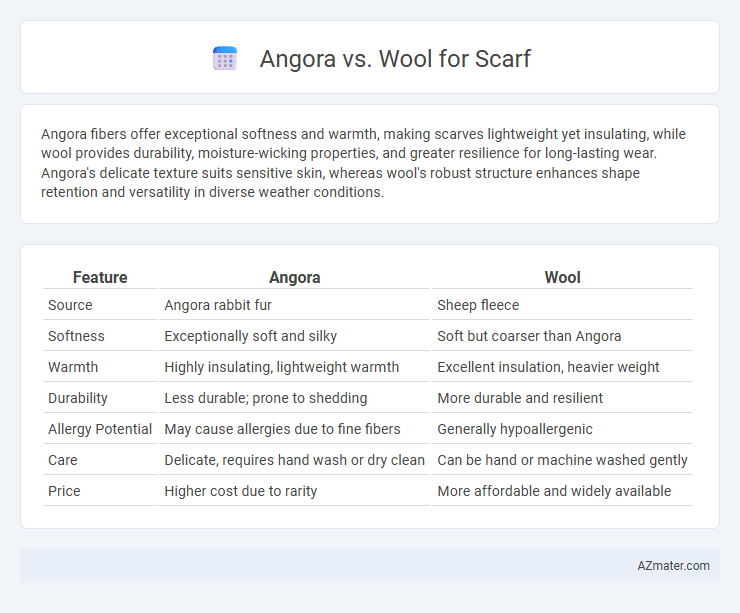Angora fibers offer exceptional softness and warmth, making scarves lightweight yet insulating, while wool provides durability, moisture-wicking properties, and greater resilience for long-lasting wear. Angora's delicate texture suits sensitive skin, whereas wool's robust structure enhances shape retention and versatility in diverse weather conditions.
Table of Comparison
| Feature | Angora | Wool |
|---|---|---|
| Source | Angora rabbit fur | Sheep fleece |
| Softness | Exceptionally soft and silky | Soft but coarser than Angora |
| Warmth | Highly insulating, lightweight warmth | Excellent insulation, heavier weight |
| Durability | Less durable; prone to shedding | More durable and resilient |
| Allergy Potential | May cause allergies due to fine fibers | Generally hypoallergenic |
| Care | Delicate, requires hand wash or dry clean | Can be hand or machine washed gently |
| Price | Higher cost due to rarity | More affordable and widely available |
Introduction to Angora and Wool Scarves
Angora scarves are crafted from the soft, silky fibers of the Angora rabbit, renowned for their exceptional warmth and lightweight feel. Wool scarves, derived from sheep's fleece, offer durable insulation and moisture-wicking properties, making them ideal for cold weather. Both materials provide unique textures and thermal benefits, with Angora favoring softness and luxury, while wool emphasizes resilience and practicality.
Origin and Source of Angora and Wool
Angora fibers are derived from the Angora rabbit, primarily found in regions like Turkey, France, and China, known for their silky and lightweight texture. Wool, on the other hand, comes from sheep breeds worldwide, including Merino sheep from Spain, prized for its warmth and durability. The sourcing of Angora is more delicate, requiring periodic shearing, while wool is typically sheared annually from sheep.
Texture and Softness Comparison
Angora fibers, harvested from Angora rabbits, are renowned for their exceptional softness and silky texture, offering a lightweight and luxurious feel ideal for scarves. Wool, derived from sheep, provides a coarser texture with more durability and warmth but can sometimes be itchy depending on the breed. Angora scarves excel in softness and smoothness compared to wool, making them preferable for sensitive skin and elegantly draping accessories.
Warmth and Insulation Properties
Angora offers exceptional warmth and insulation due to its hollow fiber structure, trapping air and retaining heat better than regular wool. Wool provides good insulation with its dense fiber composition that naturally repels moisture while maintaining warmth. For scarves, Angora delivers a softer, warmer experience, making it ideal for extreme cold, whereas wool offers durable insulation with moisture-wicking benefits for versatile weather conditions.
Breathability and Moisture-Wicking
Angora fibers are renowned for their exceptional breathability, allowing air to circulate freely and keeping the wearer cool and comfortable, which is ideal for scarves worn in varying temperatures. Wool also offers good breathability and excels in moisture-wicking by drawing sweat away from the skin, preventing dampness and maintaining warmth even in wet conditions. Compared to wool, angora tends to be softer and lighter but may retain more moisture, making wool the preferred choice for enhanced moisture management in scarves.
Durability and Longevity
Angora fibers, derived from the Angora rabbit, are known for their softness and warmth but tend to be less durable and more prone to pilling compared to traditional wool. Wool scarves, made from sheep's fleece, offer greater resilience and longevity due to their natural elasticity and moisture-wicking properties, making them ideal for everyday use. Choosing wool enhances scarf durability with its robust fiber structure, ensuring extended wear and better resistance to abrasion over time.
Hypoallergenic Considerations
Angora fiber, sourced from Angora rabbits, is often hypoallergenic compared to traditional wool, reducing the risk of skin irritation and allergic reactions in sensitive individuals. Wool, particularly from sheep, contains lanolin, which can trigger allergies or itching, making it less suitable for those with sensitive skin. Choosing Angora scarves offers a softer, less allergenic option while maintaining warmth and durability.
Sustainability and Ethical Factors
Angora scarves, derived from the Angora rabbit, offer a luxuriously soft texture but raise sustainability concerns due to potential animal welfare issues if not sourced from ethical farms practicing cruelty-free harvesting methods. Wool scarves, primarily made from sheep fleece, present a more widely available and biodegradable option with a lower environmental footprint when sourced from responsible farms utilizing sustainable grazing and shearing practices. Evaluating certifications like Responsible Wool Standard (RWS) or animal welfare labels ensures both materials align better with ethical consumption goals.
Cost and Value for Money
Angora scarves generally cost more than wool scarves due to the labor-intensive harvesting process and limited supply of angora fibers. Wool scarves offer better value for money by providing warmth, durability, and affordability, making them accessible for everyday use. However, angora scarves deliver exceptional softness and luxurious texture, appealing to those willing to invest in premium quality.
Choosing the Best Material for Your Scarf
Angora offers exceptional softness and warmth, making it ideal for scarves that require a luxurious feel and lightweight insulation, while wool provides greater durability and moisture-wicking properties for everyday wear. Angora fibers are finer and more delicate, best suited for gentle care, whereas wool's robust structure withstands frequent use and washing. Selecting the best material depends on your preference for comfort versus longevity, with angora excelling in softness and wool delivering practicality and resilience.

Infographic: Angora vs Wool for Scarf
 azmater.com
azmater.com